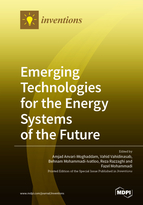Emerging Technologies for the Energy Systems of the Future
A special issue of Inventions (ISSN 2411-5134). This special issue belongs to the section "Inventions and Innovation in Electrical Engineering/Energy/Communications".
Deadline for manuscript submissions: closed (31 December 2020) | Viewed by 42880
Special Issue Editors
Interests: power system operation and planning; microgrids and active energy networks; energy markets and analytics; operations research and its applications to energy systems
Special Issues, Collections and Topics in MDPI journals
Interests: energy systems integration; whole energy systems; operation of smart grids/microgrids/building; energy markets; transactive energy
Special Issues, Collections and Topics in MDPI journals
Interests: smart energy systems, machine learning, uncertainty management, decision making, renewable energy sources
Special Issues, Collections and Topics in MDPI journals
Interests: power system protection and control; microgrids; distributed energy resources
Special Issues, Collections and Topics in MDPI journals
Interests: power systems control and operation; power systems planning and reliability; power systems protection and stability; high-voltage engineering; microgrids; smart grid
Special Issues, Collections and Topics in MDPI journals
Special Issue Information
Dear Colleagues,
Energy systems are transiting from conventional energy systems to modernized and smart energy systems. This Special Issue covers new advances in the emerging technologies for modern energy systems from both technical and management perspectives. In modern energy systems, an integrated and systematic view of different energy systems, from local energy systems and islands to national and multi-national energy hubs, is important. From the customer perspective, a modern energy system is required to have more intelligent appliances and smart customer services. In addition, customers require the provision of more useful information and control options. Another challenge for energy systems of the future is the increased penetration of renewable energy sources. Hence, new operation and planning tools are required for hosting renewable energy sources as much as possible. We invite all interested researchers to submit their original research and review papers for this Special Issue; topics of interest include, but are not limited to:
- Energy systems integration;
- Micro- and nano-energy systems and technologies;
- Operation and control of energy systems;
- Integrated community-based energy systems;
- Local energy systems;
- Energy islands;
- Multi-stakeholder energy systems;
- Energy conversion, conservation, and management;
- Multi-carrier and integrated energy systems;
- Energy storage systems;
- Demand-side management;
- IoT for smart grid;
- Flexibility services in integrated energy systems;
- Renewable energy hosting capacity;
- The market for flexibility services;
- Role of cloud/edge computing technology on energy systems modernization;
- Effect of ICT and cybersecurity trends on energy systems of the future;
- Vector coupling energy storage systems;
- Low-carbon technologies in energy systems;
- eMobility;
- Big data in energy systems
Prof. Dr. Amjad Anvari-Moghaddam
Dr. Vahid Vahidinasab
Prof. Behnam Mohammadi-Ivatloo
Dr. Reza Razzaghi
Dr. Fazel Mohammadi
Guest Editors
Manuscript Submission Information
Manuscripts should be submitted online at www.mdpi.com by registering and logging in to this website. Once you are registered, click here to go to the submission form. Manuscripts can be submitted until the deadline. All submissions that pass pre-check are peer-reviewed. Accepted papers will be published continuously in the journal (as soon as accepted) and will be listed together on the special issue website. Research articles, review articles as well as short communications are invited. For planned papers, a title and short abstract (about 100 words) can be sent to the Editorial Office for announcement on this website.
Submitted manuscripts should not have been published previously, nor be under consideration for publication elsewhere (except conference proceedings papers). All manuscripts are thoroughly refereed through a single-blind peer-review process. A guide for authors and other relevant information for submission of manuscripts is available on the Instructions for Authors page. Inventions is an international peer-reviewed open access semimonthly journal published by MDPI.
Please visit the Instructions for Authors page before submitting a manuscript. The Article Processing Charge (APC) for publication in this open access journal is 1800 CHF (Swiss Francs). Submitted papers should be well formatted and use good English. Authors may use MDPI's English editing service prior to publication or during author revisions.










